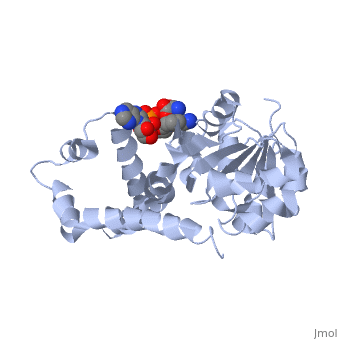| Structural highlights
Disease
P5CR1_HUMAN Defects in PYCR1 are the cause of cutis laxa autosomal recessive type 2B (ARCL2B) [MIM:612940. A multisystem disorder characterized by the appearance of premature aging, wrinkled and lax skin with reduced elasticity, joint laxity, craniofacial dysmorphic features, intrauterine growth retardation with some degree of postnatal growth deficiency, and developmental delay.[1] [2] Defects in PYCR1 are the cause of cutis laxa, autosomal recessive, type 3B (ARCL3B) [MIM:614438. ARCL3B is a disorder characterized by an aged appearance with distinctive facial features, sparse hair, ophthalmologic abnormalities, intrauterine growth retardation, and cutis laxa.[3] [4]
Function
P5CR1_HUMAN Housekeeping enzyme that catalyzes the last step in proline biosynthesis. Can utilize both NAD and NADP, but has higher affinity for NAD. Involved in the cellular response to oxidative stress.[5] [6]
Evolutionary Conservation
Check, as determined by ConSurfDB. You may read the explanation of the method and the full data available from ConSurf.
Publication Abstract from PubMed
Pyrroline-5-carboxylate reductase (P5CR) is a universal housekeeping enzyme that catalyzes the reduction of Delta(1)-pyrroline-5-carboxylate (P5C) to proline using NAD(P)H as the cofactor. The enzymatic cycle between P5C and proline is very important for the regulation of amino acid metabolism, intracellular redox potential, and apoptosis. Here, we present the 2.8 Angstroms resolution structure of the P5CR apo enzyme, its 3.1 Angstroms resolution ternary complex with NAD(P)H and substrate-analog. The refined structures demonstrate a decameric architecture with five homodimer subunits and ten catalytic sites arranged around a peripheral circular groove. Mutagenesis and kinetic studies reveal the pivotal roles of the dinucleotide-binding Rossmann motif and residue Glu221 in the human enzyme. Human P5CR is thermostable and the crystals were grown at 37 degrees C. The enzyme is implicated in oxidation of the anti-tumor drug thioproline.
Crystal structure of human pyrroline-5-carboxylate reductase.,Meng Z, Lou Z, Liu Z, Li M, Zhao X, Bartlam M, Rao Z J Mol Biol. 2006 Jun 23;359(5):1364-77. Epub 2006 May 11. PMID:16730026[7]
From MEDLINE®/PubMed®, a database of the U.S. National Library of Medicine.
See Also
References
- ↑ Reversade B, Escande-Beillard N, Dimopoulou A, Fischer B, Chng SC, Li Y, Shboul M, Tham PY, Kayserili H, Al-Gazali L, Shahwan M, Brancati F, Lee H, O'Connor BD, Schmidt-von Kegler M, Merriman B, Nelson SF, Masri A, Alkazaleh F, Guerra D, Ferrari P, Nanda A, Rajab A, Markie D, Gray M, Nelson J, Grix A, Sommer A, Savarirayan R, Janecke AR, Steichen E, Sillence D, Hausser I, Budde B, Nurnberg G, Nurnberg P, Seemann P, Kunkel D, Zambruno G, Dallapiccola B, Schuelke M, Robertson S, Hamamy H, Wollnik B, Van Maldergem L, Mundlos S, Kornak U. Mutations in PYCR1 cause cutis laxa with progeroid features. Nat Genet. 2009 Sep;41(9):1016-21. doi: 10.1038/ng.413. Epub 2009 Aug 2. PMID:19648921 doi:10.1038/ng.413
- ↑ Guernsey DL, Jiang H, Evans SC, Ferguson M, Matsuoka M, Nightingale M, Rideout AL, Provost S, Bedard K, Orr A, Dube MP, Ludman M, Samuels ME. Mutation in pyrroline-5-carboxylate reductase 1 gene in families with cutis laxa type 2. Am J Hum Genet. 2009 Jul;85(1):120-9. doi: 10.1016/j.ajhg.2009.06.008. Epub 2009 , Jul 2. PMID:19576563 doi:10.1016/j.ajhg.2009.06.008
- ↑ Reversade B, Escande-Beillard N, Dimopoulou A, Fischer B, Chng SC, Li Y, Shboul M, Tham PY, Kayserili H, Al-Gazali L, Shahwan M, Brancati F, Lee H, O'Connor BD, Schmidt-von Kegler M, Merriman B, Nelson SF, Masri A, Alkazaleh F, Guerra D, Ferrari P, Nanda A, Rajab A, Markie D, Gray M, Nelson J, Grix A, Sommer A, Savarirayan R, Janecke AR, Steichen E, Sillence D, Hausser I, Budde B, Nurnberg G, Nurnberg P, Seemann P, Kunkel D, Zambruno G, Dallapiccola B, Schuelke M, Robertson S, Hamamy H, Wollnik B, Van Maldergem L, Mundlos S, Kornak U. Mutations in PYCR1 cause cutis laxa with progeroid features. Nat Genet. 2009 Sep;41(9):1016-21. doi: 10.1038/ng.413. Epub 2009 Aug 2. PMID:19648921 doi:10.1038/ng.413
- ↑ Lin DS, Chang JH, Liu HL, Wei CH, Yeung CY, Ho CS, Shu CH, Chiang MF, Chuang CK, Huang YW, Wu TY, Jian YR, Huang ZD, Lin SP. Compound heterozygous mutations in PYCR1 further expand the phenotypic spectrum of De Barsy syndrome. Am J Med Genet A. 2011 Dec;155A(12):3095-9. doi: 10.1002/ajmg.a.34326. Epub 2011 , Nov 3. PMID:22052856 doi:10.1002/ajmg.a.34326
- ↑ Reversade B, Escande-Beillard N, Dimopoulou A, Fischer B, Chng SC, Li Y, Shboul M, Tham PY, Kayserili H, Al-Gazali L, Shahwan M, Brancati F, Lee H, O'Connor BD, Schmidt-von Kegler M, Merriman B, Nelson SF, Masri A, Alkazaleh F, Guerra D, Ferrari P, Nanda A, Rajab A, Markie D, Gray M, Nelson J, Grix A, Sommer A, Savarirayan R, Janecke AR, Steichen E, Sillence D, Hausser I, Budde B, Nurnberg G, Nurnberg P, Seemann P, Kunkel D, Zambruno G, Dallapiccola B, Schuelke M, Robertson S, Hamamy H, Wollnik B, Van Maldergem L, Mundlos S, Kornak U. Mutations in PYCR1 cause cutis laxa with progeroid features. Nat Genet. 2009 Sep;41(9):1016-21. doi: 10.1038/ng.413. Epub 2009 Aug 2. PMID:19648921 doi:10.1038/ng.413
- ↑ Meng Z, Lou Z, Liu Z, Li M, Zhao X, Bartlam M, Rao Z. Crystal structure of human pyrroline-5-carboxylate reductase. J Mol Biol. 2006 Jun 23;359(5):1364-77. Epub 2006 May 11. PMID:16730026 doi:10.1016/j.jmb.2006.04.053
- ↑ Meng Z, Lou Z, Liu Z, Li M, Zhao X, Bartlam M, Rao Z. Crystal structure of human pyrroline-5-carboxylate reductase. J Mol Biol. 2006 Jun 23;359(5):1364-77. Epub 2006 May 11. PMID:16730026 doi:10.1016/j.jmb.2006.04.053
|


